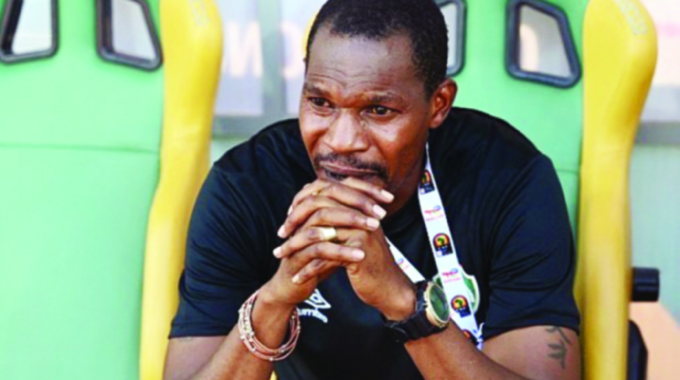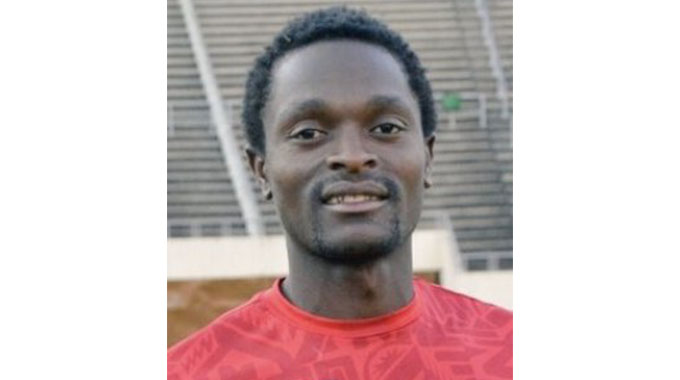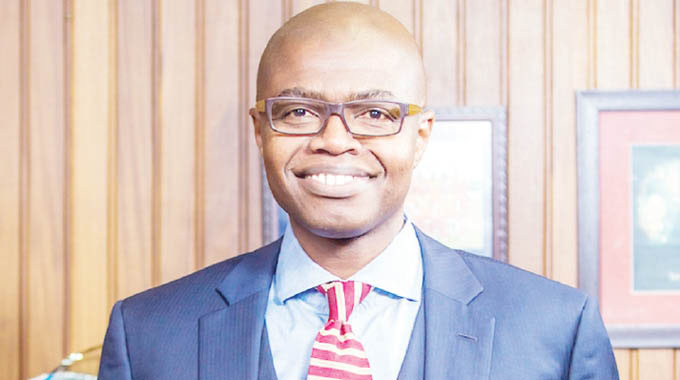A Flying Doc, A Phil Collins

Sharuko On Saturday
THE huge banner carried a simple yet very powerful, and even poetic, message of love – ‘TAUYA KUZOONA TAUYA’.
At the fortress called Vietnam, the stand which used to represent the bastion of loyalty to the Dynamos badge, the banner became a common sight.
For about two to three years, it flew proudly at Rufaro, back in the days when this old stadium was the grand island which the Glamour Boys called home sweet home.
The guys who always brought the banner were University of Zimbabwe students.
Each of them was an island of fine intellectual capacity, a symbol of this country’s future leadership, in commerce as in industry, and an oasis of hope for their beautiful nation.
For each of them, this was a weekly pilgrimage for a romantic date with one of their own.
Their hero, the charming boy from one of their hostels, the fellow from the little town of Mvuma with a talent, and a brain, to produce a perfect mixture of a hero.
He was amazingly cool, very, very reserved, a fine athlete, a talented footballer and he played for the team of their dreams, back in the days when Dynamos were the Glamour Boys.
Their romantic attachment to him was pure, they were unapologetic about it.
And, on those beautiful Sunday afternoons, they could temporarily forget about assignments, college and all its related challenges, as they found someone who could always provide a valve for them to release their emotions.
The TAUYA, which those students always kept reminding us they had come to watch, was TAUYA MUREWA.
The only doctor known to have found a way to be a flying object, on the football field, the university student who transformed himself into the poster boy of a very strong DeMbare side.
He had pace, lightning pace, especially once he had the ball laced to his feet, he was a master of the cheeky body swerve, repeatedly making a fool of some of the toughest defenders to grace local football.
He had a rare package, a mixture of football beauty and brains, the guy who was hard to hate and even impossible to ignore.
At his flying best, his skills provided a box-office package which was a gold mine for seduction, the power which used to woo fans into his growing army of followers.
His explosion resembled that of a shooting star. He used to float like a butterfly and sting like a bee, a relentless destroyer of defences, who did it with such beautiful ease, and amazing beauty, he became the face of the Glamour Boys. And, of course, the symbol, and spirit, of his proud university.
These were the sights and sounds of the ‘90s, the middle part of the decade, when local football was quite healthy and the domestic Premiership was still a playground for fine artists.
One of them was called Usman Misi.
He was so good they even nicknamed Huchi, which translates to honey, as imaginative a nickname as any which has been associated with the beautiful game.
To them, he was the provider of sweetness, the one who always delivered a sweet taste, with his bag of silky skills.
A football genius from the east, who had seemingly perfected the art of making a mockery of the barriers, otherwise known as defenders, which various coaches would throw into his path.
That he made such a big impression, when he played for a club like Darryn T, which was on the periphery, at a time when support was monopolised by the Big Boys, puts into context his special qualities.
If Usman Misi had played in this era, he would have been Soccer Star of the Year in 2010, 2011, 2012, 2013, 2014, 2015, 2016, 2017, 2018, 2019 and 2022.
The only two years, in the past dozen years, in which he would have missed being crowned Soccer Star of the Year, would have been in 2020 and 2021.
Why?
Because local football was not played, for such an extended period of time, for the game to find a way to pick the players who could be crowned the stars of the show.
THIS WAS BOX OFFICE ENTERTAINMENT
At some point, during the ‘90s, it appeared as if places like Mabvuku, Chitungwiza, Mufakose, Highfield, Glen Norah and Mbare, were in an undeclared war to try and show which community had the best nursery in producing football stars.
An undeclared war to see which area would provide the biggest number of winners of the Soccer Star of the Year award.
Mabvuku struck gold in 1992 when the Silver Fox, Wilfred Mugeyi, was crowned Soccer Star of the Year after leading Black Aces to the league championship.
In 1994, Mufakose hit back, when Memory Mucherahowa took the award home, for his starring and leadership role, in Dynamos’ success story in the championship race that year.
The following year, the University of Zimbabwe had its moment, something which even the great Roderick Muganhiri, had failed to give this proud campus, during his magical years at Black Aces.
Like Tauya, Roderick was a doctor, and a fine footballer, a humble man who never let his intelligence give him a sense of superiority, among teammates, many of whom were not at the same level of intellect.
In 1996, Chitungwiza celebrated its finest hour when one of its sons, Stewart Murisa, took the Soccer Star of the Year award home, a fitting tribute for his excellent breakthrough campaign with CAPS United.
It’s likely Alois Bunjira, another Chitown boy, would have won the award, and no one would have cried foul because, during that season, he was also unplayable.
A season-ending injury, when the campaign still had another three months to play, meant Bunjira was robbed of more time to make a claim for his case.
But, it’s a measure of how good he was that season that he lost the Soccer Star of the Year award by just one vote and was comforted with the Kingsgate Player of the Year gong.
To get a good impression of the impact that Murisa and Bunjira had, in 1995 and 1996, one needs to note that, in both seasons, they inspired clubs which never ended with fewer points than the champions.
In ’95, they powered Blackpool to 58 points, the same as champions Dynamos, and Ndochi would have been champions, had a late goal, in their final 3-1 win over Tongogara in Kwekwe, not been controversially disallowed.
That goal, just one goal, would have been enough to give Blackpool the league title, by virtue of a superior goal difference, to Dynamos.
The following year, at their new home, they helped CAPS United win their first league championship, in 17 years, or to put it into proper context, their first title after Independence.
By 1997, the Green Machine had a new hero, their latest recruit from Darryn T, via Blackpool, yet another import from Chitown, midfielder Edelbert Dinha.
Unlike Bunjira and Murisa, Dinha was a rather laid-back character, an athlete who appeared uncomfortable in the media spotlight, a footballer who simply wanted his football to do the talking.
And, talk it did, with consistent performances, at the heart of a Green Machine where expectations had risen, fuelled by their landmark success story the previous year, when CAPS United had finally tasted the sweet taste of success. This was Dinha’s Makepekepe, to a large extent, and he became the heart and soul of the team, a fine performer, a fearless and competent warrior, a superb leader on the pitch. He was like some kind of Roy Keane, without the Irishman’s anger, the guy whose real value you didn’t see, when he was in the team, but whose absence would always be greatly felt, on the occasions he was not on the field.
His main weapon was his consistency, game after game, opponent after opponent, nothing seemed to overwhelm him, nothing seemed to faze him.
They nicknamed him Phil Collins, after the British singer who, in 1997, was rocking the world with his smash hit song, “Dance Into The Light.”
I’m not sure why Charles Mabika gave him that nickname. But, I will make a rough guess that my good old colleague, also known as “CNN”, believed Dinha was dragging the Green Machine fans into a beautiful world where they would be dancing into the light.
By November that year it had become clear that the two best players in the league were the Flying Doctor and Phil Collins.
Tauya Murewa and Edelbert Dinha!
In a way, Dynamos versus CAPS United – quite a gripping contest.
Coming as it did at a time when the rivalry between the two clubs had gone a notch higher in the wake of the Green Machine’s revival into a championship-winning club again.
Dinha was the ice-cool midfield artist, defensively strong and offensively brilliant, a footballer who was ticking all the boxes despite a reluctance to dance in the spotlight.
Tauya was still flying, at an altitude higher than when he won the Soccer Star of the Year in ‘95, at a pace that was still destructive for the hurdles thrown into his path.
THE FARCE THAT TAINTED A GONG
It was a beautiful time to be a fan of the domestic Premiership, the league was losing its stars to Supa Diski in numbers.
But, it defiantly kept parading more gems and, in terms of a breakout season that year, none better than Edelbert Dinha.
Back in 1997, I was the chairman of the Sportswriters Association of Zimbabwe, the body which coordinated and conducted the selection of the Soccer Stars of the Year.
On Wednesday, three days before the selection process for the Soccer Stars of the Year was held, I was told I had to travel to the Eastern Highlands to cover the Leopard Rock Golf Classic.
I left the following day for a weekend recording birdies and bogeys, far away from the madding crowd of the capital, right in the heart of the tranquillity which only nature can provide.
But such serenity was just an illusion as some storm clouds had been gathering and Black Friday struck with our dollar losing 75 percent of its value to the United States greenback.
It was against the background of that chaos that my fellow sportswriters met in Harare, on Saturday, for a Soccer Stars of the Year selection process which would destroy this grand award.
This year marks a quarter-of-a-century since that fateful indaba and 25 years later, the events of that wild day are still being felt when it comes to this award.
Dinha’s disqualification was very, very controversial.
That it came on the day of the selection didn’t help matters either and there was no doubt it would have serious consequences.
It was taken by both the combined pro-CAPS United and anti-Dynamos camp, among the football writers and commentators, as a deliberate move to try and clear the path for Tauya to be the Soccer Star of the Year.
The guys who backed the disqualification maintained they stuck to the rule book, when it came to the number of yellow cards which a footballer should receive, to be eligible for selection. What followed next was a farce, a story told by a drunkard, full of sound and fury, yet signifying nothing, the use of a number of words to say nothing, a classic insult to values of professionalism as a rebellion tainted this great award forever.
The rebels designed a plan, in which they would hit back by using the collective power of their votes on a single mission — to ensure that Tauya would not win the award.
Well, it was a simple but effective plan.
Once the 11 Soccer Stars of the Year have been selected, the process goes into the final round of choosing the Soccer Star of the Year and his two runners-up.
These are picked from the 11 stars, who would have made the grade, and selectors pick their three choices in order of preference.
Each choice for the Soccer Star of the Year gets five votes, each choice for the first runner-up gets three votes and each choice for the second runner-up gets one point.
He who wins the most points becomes Soccer Star of the Year.
The rebellious crew devised a plan in which Tauya’s name, which should have been a common feature among the choice of three, never appeared in any of their ballots.
By doing that, they ensured he never picked a vote from them, not for number two or number three, while his rivals were picking points from the other bloc, which believed he was the Soccer Star of the Year, either as number two or number three.
In this theatre of chaos, the tainted process produced a shock winner, Walter Tshuma of Hwange, and in the ensuing backlash, the sponsors Castle Lager, refused to endorse the sham poll and withdrew their funding for the coronation party.
The award disappeared from the radar for two years and did not return until the turn of the millennium when Zenzo Moyo was a fully deserved winner in 2000.
Twenty five years have passed since that farce and, even though a quarter-of-a-century has passed, time has failed to heal the wounds of that day in Harare, in 1997, when this gong was tainted by shame.
What time hasn’t diluted is the fact that 25 years ago we had the privilege of having company, and being entertained, by two amazing football stars.
Their legacy should never be rooted in the mess of that Soccer Stars of the Year selection farce.
To God Be The Glory!
Peace to the GEPA Chief, the Big Fish, George Norton, Daily Service, Sitting Bull, Crazy Horse and all the Chakariboys still in the struggle.
Come on United!!!!!!!!!!!!!!!!!!!!!!!!!
Ronaldoooooooooooooooooooooo!
Text Feedback 0772545199
WhatsApp 0772545199
Email – [email protected]
You can also interact with me on Twitter (@Chakariboy), Facebook, Instagram (sharukor) and Skype (sharuko58) and GamePlan, the authoritative football magazine show on ZTV, where I interact with the legendary Charles “CNN” Mabika, is back every Wednesday night at 9.30pm








Comments